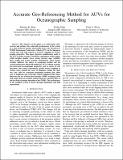| dc.contributor.author | Khan, Rubaina R. | |
| dc.contributor.author | Taher, Tawfiq | |
| dc.contributor.author | Hover, Franz S. | |
| dc.date.accessioned | 2013-04-26T19:13:06Z | |
| dc.date.available | 2013-04-26T19:13:06Z | |
| dc.date.issued | 2010-09 | |
| dc.identifier.isbn | 978-1-4244-4333-8 | |
| dc.identifier.isbn | 978-1-4244-4332-1 | |
| dc.identifier.uri | http://hdl.handle.net/1721.1/78630 | |
| dc.description.abstract | The objective of the paper is to understand, characterize and enhance the achievable performance of the system of a state-of-the-art marine observation device, the Oceanserver IVER2 Autonomous Underwater Vehicle(AUV), in the Singapore coastal zone and with regard to accurate sampling of oceanographic properties. This paper discusses modifications made to the AUV, in order to make it useful for experiments in this region, which includes shallow water, strong currents, poor visibility, heavy traffic and a poor acoustic environment. These factors strongly influence the choice of navigation method and the system architecture which will enable the AUV to obtain accurate geo-referenced oceanographic properties, and to ensure its safe operation. Our science experiments usually involve sampling at various areas around the coast of Singapore within the same day; this calls for consistent positioning methods that allow ease in deploying and retrieving related equipment. This paper illustrates the use of ultra-short baseline (USBL) tracking system and ranges from an acoustic modem fused by a particle filter to aid the dead reckoning algorithm of the IVER2. The performance of the modified system is shown through simulations and field experiments. | en_US |
| dc.language.iso | en_US | |
| dc.publisher | Institute of Electrical and Electronics Engineers (IEEE) | en_US |
| dc.relation.isversionof | http://dx.doi.org/10.1109/OCEANS.2010.5664570 | en_US |
| dc.rights | Article is made available in accordance with the publisher's policy and may be subject to US copyright law. Please refer to the publisher's site for terms of use. | en_US |
| dc.source | IEEE | en_US |
| dc.title | Accurate Geo-Referencing Method for AUVs for Oceanographic Sampling | en_US |
| dc.type | Article | en_US |
| dc.identifier.citation | Khan, Rubaina R., Tawfiq Taher, and Franz S. Hover. Accurate Geo-referencing Method for AUVs for Oceanographic Sampling. In Pp. 1–5. 2010, IEEE. © Copyright 2010 IEEE | en_US |
| dc.contributor.department | Massachusetts Institute of Technology. Department of Mechanical Engineering | en_US |
| dc.contributor.mitauthor | Hover, Franz S. | |
| dc.relation.journal | OCEANS 2010 | en_US |
| dc.eprint.version | Final published version | en_US |
| dc.type.uri | http://purl.org/eprint/type/ConferencePaper | en_US |
| dspace.orderedauthors | Khan, Rubaina R.; Taher, Tawfiq; Hover, Franz S. | en |
| dc.identifier.orcid | https://orcid.org/0000-0002-2621-7633 | |
| mit.license | PUBLISHER_POLICY | en_US |
| mit.metadata.status | Complete | |
